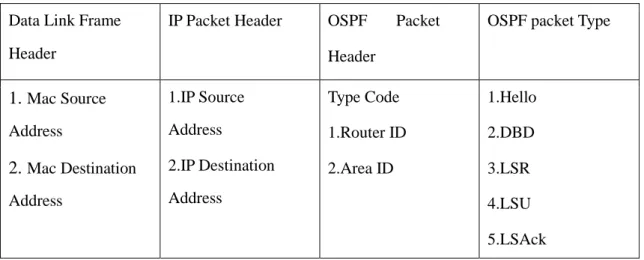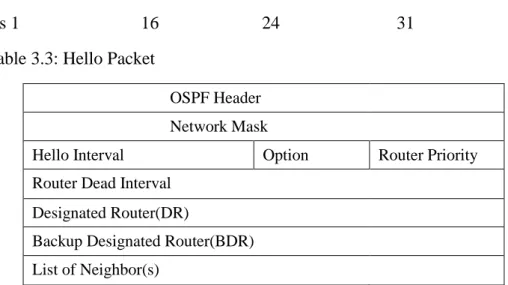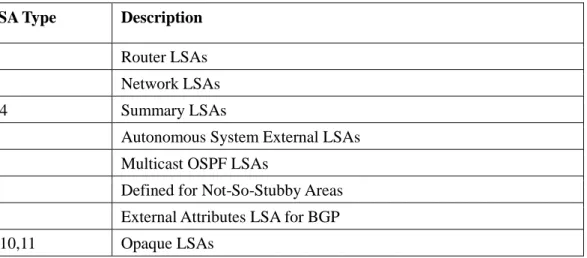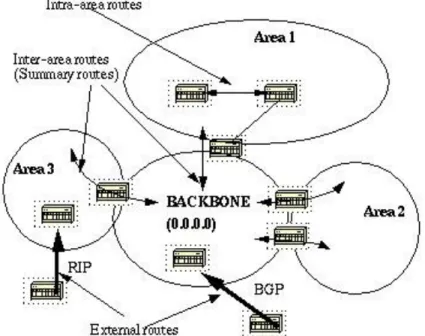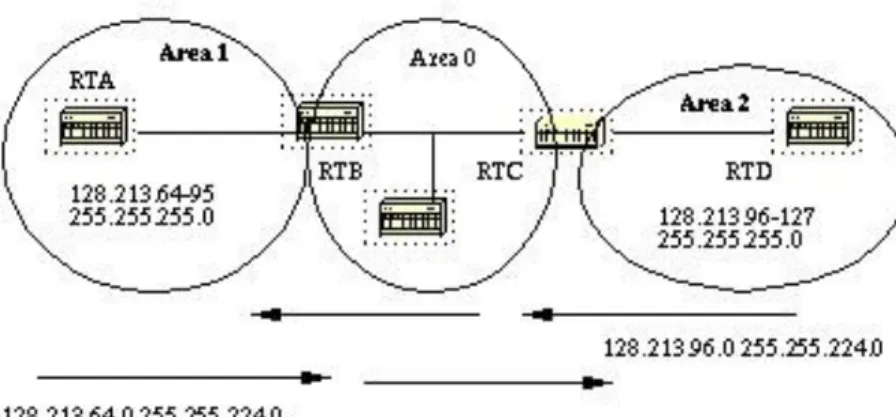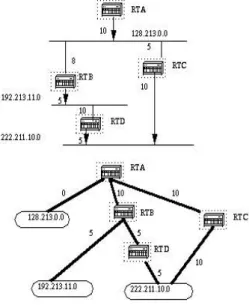Among various routing protocols, Enhanced Interior Gateway Routing Protocol (EIGRP) and Open Shortest Path First (OSPF) have been considered as the prominent routing protocols for the real-time application. There are different number of static and dynamic routing protocols available but it is very important to choose the right protocol among them. The evaluation of the routing protocols is performed based on quantitative measurements such as convergence time, packet delay variation, end-to-end delay and throughput and packet loss through the simulated network models.
Computer communication networks are based on a technology that provides the technical infrastructure, where routing protocols are used to send packets over the Internet. Among all routing protocols, we selected EIGRP and OSPF routing protocols to conduct performance evaluation in a simulation-based network model for real-time application such as video streaming and voice conferencing. The motivation behind the thesis is to get better performance in the case of choosing routing protocols between EIGRP and OSPF on the same network configuration for real-time applications, such as video streaming and voice conferencing.
Our first goal is to study routing protocols and thus increase our knowledge. The main idea for routing protocols is to determine the best path from the source to the destination. For conventional routing protocols, networks are classified as Link State Routing Protocols and Distance Vector Routing Protocols.
These databases provide information of the switching costs in the network and then a routing table is formed.

Link State Advertisement (LSA)
In Figure 3.5, it shows that a network diagram specified with the interface costs to find the shortest path [14]. Påskelilje International University Page 32 Now look at the case in figure 4.3 [3], where the connection from A to B fails. We assume in Figure 4.4 that the link from R3 and R5 goes down and at the same time R3 identifies the error in the link.
An Application Definition Object and a Profile Definition Object named respectively Application Config and Profile Config in Figure 5.2 are added from the object palette to the workspace. From the above Figure 5.7, it can be seen that the convergence time of EIGRP is faster than OSPF and EIGRP_OSPF networks. Påskelilje International University Page 43 In Figure 5.7 indicates that the convergence time of EIGRP is reduced rapidly with the increase of the OSPF network.
It is seen from Figure 5.8 that EIGRP_OSPF has less packet delay variation than EIGRP and OSPF networks. It can be seen from Figure 5.8 that the packet delay variation of EIGRP and OSPF networks has higher than the EIGRP_OSPF network. Apparently, Figure 5.8 showed that despite high congestion in the network, EIGRP_OSPF is very.
As shown in figure 5.9, end to end delay of EIGRP_OSPF network is relatively less than OSPF network. As shown in figure 5.10, it is observed that some packets are dropped due to high congestion in the network when the background load is 95%. As shown in figure 5.11, it is observed that some packets are dropped due to high congestion in the network when the background load is 95%.
As shown in figure 5.12, it can be seen that OSPF network has slightly higher jitter than EIGRP and EIGRP_OSPF networks at the beginning. As shown in figure 5.14, the OSPF network has less packet loss than EIGRP and EIGRP_OSPF networks. In comparison, the simulation results showed that the throughput in the combination of EIGRP and OSPF network is much higher than OSPF and EIGRP networks.
![Figure 3.4 illustrates the different types of LSAs [14].](https://thumb-ap.123doks.com/thumbv2/filepdfnet/10795525.0/34.892.254.726.465.755/figure-3-4-illustrates-different-types-lsas-14.webp)
INTERIOR GATEWAY ROUTING PROTOCOL
Advantages and Disadvantages of EIGRP
EIGRP convergence time is low and is responsible for reducing bandwidth utilization. A simulation can be defined to show the possible actual behavior of the selected system model. We use it to optimize performance based on the creation of a system model with the aim of gaining insight. Using the simulation results, we can predict the estimation and assumption of the real system.
Simulator
Design and Analysis in OPNET
Simulation Study
Network Topology
The network topology design is based on the geographical layout of Bangladesh shown below in Figure 5.3. We considered six sub-networks according to department name in Bangladesh which are interconnected. As for the real-time applications in our thesis, the application definition object is set to support video streaming (light) and voice conferencing (PCM quality).
A profile definition object defines the profiles within the defined application traffic of the application definition objects. One of the profiles has the application support of Video Streaming (Light) and another one has Voice Conference support (PCM quality). Failure events introduce disturbances in the routing topology, leading to additional intervals of convergence activity.
The link between Sylhet and Barishal is set to fail for 300 seconds and recovers after 500 seconds. A video server is connected to the Dhaka router, which is set to video streaming under the supported video server services. Quality of Service (QoS) plays an important role to achieve guaranteed data speed and latency in the network.
To implement QoS, IP QoS Object called QoS Parameters in the workspace where it was used to enable and deploy Weighted Fair Queuing (WFQ). WFQ is a scheduling technique that allows different scheduling priorities based on Type of Service (ToS) and Differentiated Service Code Point (DSCP).
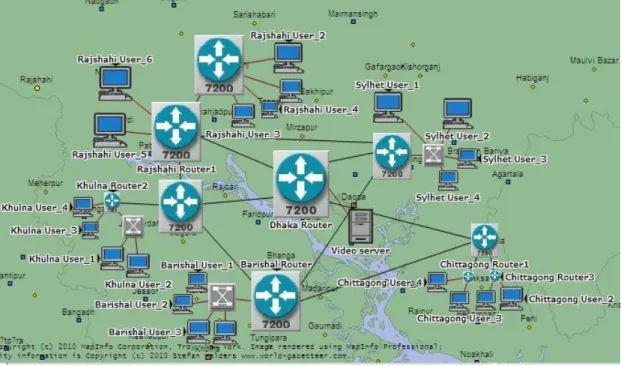
EIGRP Scenario
OSPF Scenario
EIGRP_OSPF Scenario
Measurements
Simulation Results and Analysis
Convergence Duration
Packet Delay Variation for Video Streaming
Daffodil International University Page 44 better than the other two networks in terms of packet delay variation.
End to End Delay for Video Streaming
Traffic Sent for Video Streaming
Traffic Received for Video Streaming
Voice Traffic (Jitter)
End to End delay
End-to-end delay is defined as the interval between the transmission time of data packets from the source and the arrival time to the destination. On the other hand, OSPF and EIGRP show the significant delay in the graph. The end-to-end delay of EIGRP is higher due to the lower network connection speed that causes packet loss.
Traffic Sent/Received (bytes/sec)
The detailed statistical results for OSPF, EIGRP and EIGRP_OSPF networks are shown as below.
Throughput
The throughput is a key parameter to determine the rate at which total data packets are successfully delivered through the channel in the network. Interior routing protocols such as EIGRP and OSPF are widely used in computer networking. In this thesis we presented a comparative analysis of selected routing protocols such as EIGRP, OSPF and the combination of EIGRP and OSPF.
The comparative analysis was done in the same network with different protocols for real-time applications. Performance was measured by some parameters aimed at finding out the effects of routing protocols. In our thesis work, implementation of EIGRP shows that network convergence time is much faster than EIGRP_OSPF and OSPF networks because EIGRP network learns and updates the topology information faster than EIGRP_OSPF and OSPF.
The simulation result has shown that the end-to-end delay of EIGRP_OSPF network is relatively less than that of EIGRP and OSPF networks. The performance of packet delay variation for EIGRP_OSPF is better than that of OSPF and EIGRP. We observed that the packet delay variation of EIGRP and OSPF networks is high, while EIGRP_OSPF network is low.
In the context of packet loss, we found that the packet loss in EIGRP_OSPF network is less than OSPF and EIGRP networks. In this thesis, the comparative performance between EIGRP, OSPF and the combination of EIGRP and OSPF routing protocols for real-time application is analyzed. By comparing the performances of these protocols, we found that the combined implementation of EIGRP and OSPF routing protocols in the network performs better than OSPF and EIGRP.
Daffodil International University Page 52 routing protocol performance, overall performance of EIGRP is better than OSPF. In the future, a research work can be done on the explicit features of both OSPFv3 and EIGRP protocols in the IPv4/IPv6 environment. LSDB Link State Database LSP Link State Packet LSR Link State Request LSU Link State Update NET Network Entity Title.
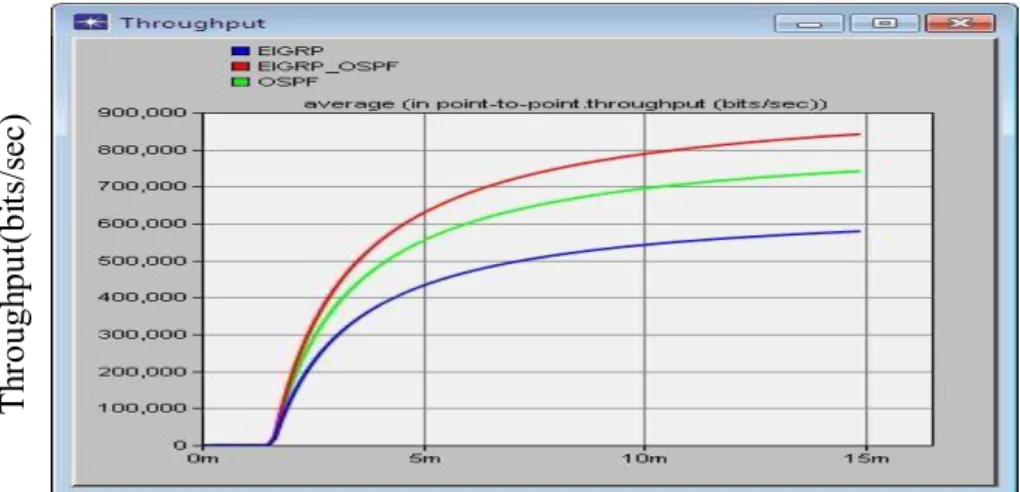
CONCLUSION AND FUTURE WORK
![Figure 2.1 is an example of a network where Classful routing is used with the same subnet mask all through the network [4]](https://thumb-ap.123doks.com/thumbv2/filepdfnet/10795525.0/21.892.236.788.589.803/figure-example-network-classful-routing-used-subnet-network.webp)
